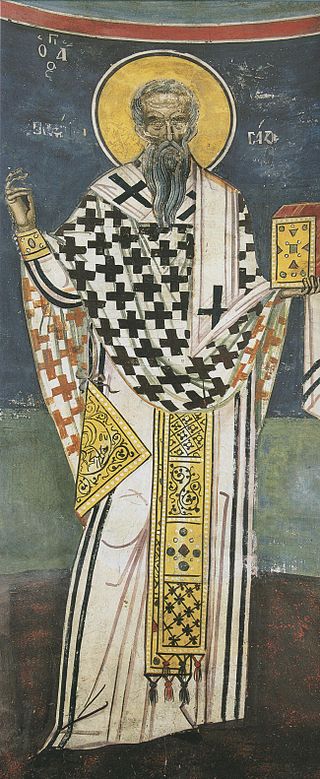Pope Agapetus I was the bishop of Rome from 13 May 535 to his death. His father, Gordianus, was a priest in Rome and he may have been related to two popes, Felix III and Gregory I.

Pope Callixtus I, also called Callistus I, was the bishop of Rome from c. 218 to his death c. 222 or 223. He lived during the reigns of the Roman emperors Elagabalus and Alexander Severus. Eusebius and the Liberian catalogue list his episcopate as having lasted five years (217–222). In 217, when Callixtus followed Zephyrinus as Bishop of Rome, he started to admit into the Church converts from sects or schisms. He was killed for being Christian and is venerated as a saint by the Catholic Church.
Pope Sixtus III was the bishop of Rome from 31 July 432 to his death on 18 August 440. His ascension to the papacy is associated with a period of increased construction in the city of Rome. His feast day is celebrated by the Roman Catholic Church and Eastern Orthodox Church on 28 March.

Porphyrius was bishop of Gaza from 395 to 420, known, from the account in his Life, for Christianizing the recalcitrant pagan city of Gaza, and demolishing its temples.

The Basilica of Sant'Apollinare in Classe is a church in Classe, Ravenna, Italy, consecrated on 9 May 549 by the bishop Maximian and dedicated to Saint Apollinaris, the first bishop of Ravenna and Classe.

Saint Geminianus was a fourth-century deacon who became Bishop of Modena. He is mentioned in the year 390, when he participated in a council called by Saint Ambrose in Milan. From his name, it has been deduced that Geminianus probably belonged to the caste of Roman senators.

Arbeoof Freising was an early medieval author and the Bishop of Freising from 764.
Adalgar, venerated as Saint Adalgar, was the third archbishop of Bremen from 888 until his death. Adalgar is revered as a saint in the Roman Catholic and Eastern Orthodox Churches. His feast day is 29 April.

Liborius of Le Mans was the second Bishop of Le Mans. He is the patron saint of the cathedral and archdiocese of Paderborn in Germany. The year of his birth is unknown; he died in 397, reputedly on 23 July.
Ernest Gordon Rupp was a Methodist preacher, historian and Luther scholar.

Ursicinus of Ravenna is venerated as a martyr by the Catholic Church. He was said to be a physician of Ravenna. His legend is connected with that of Vitalis, who is said to have encouraged the wavering Ursicinus after the physician was sentenced to death for his faith. After he was beheaded, Vitalis buried him in Ravenna.

Ursicinus was an Irish missionary and hermit in the Jura region.
Alpert of Metz was a Benedictine chronicler of the eleventh century. His De diversitate temporum is a major source for the history of Western Europe in the period it covers, which is 990 to 1021. It was dedicated to Burchard of Worms.

Conrad of Constance was a German bishop and saint.
Floribert of Liège was a bishop of Liège, who is venerated as a saint in the Eastern Orthodox Church and Roman Catholic Church. His feast day is celebrated on 27 April. He was the son of the French-born Hubert of Liège, also a saint, and whom he succeeded on his death as bishop.

Quirinus of Neuss, sometimes called Quirinus of Rome is venerated as a martyr and saint of the Catholic and Eastern Orthodox churches. His cult was centred at Neuss in Germany, though he was a Roman martyr.
Theonistus is a saint venerated by the Catholic Church. Theonistus is venerated with two companions, Tabra and Tabratha. Medieval documents give accounts of his life, which are contradictory and confusing.
Zacharias of Vienne, also sometimes Zachary or Zachariah, was traditionally the second Bishop of Vienne in what is now Isère, France, until he was supposedly martyred in 106 AD during the reign of the Emperor Trajan. He was one of the first Christian evangelists in France. He is venerated locally and is one of the patron saints of the city of Vienne. His feast day is celebrated on 26 May.

Prochorus was one of the Seven Deacons chosen to care for the poor of the Christian community in Jerusalem. According to later tradition, he was also one of the Seventy Disciples sent out by Jesus in Luke 10.

Ecclesius was bishop of Ravenna from AD 521 to 532. He is best known as the founder of the Basilica of San Vitale in Ravenna.












